Abstract
Society of the early 21th century is characterized by a rapid complication of processes in social, economic and cultural spheres, what leads to an increasingly obvious fragmentation of human existence, which is a reason behind individualization. Proceeding form this, individualization can be understood as a socio-historical concept relating to life situations and people’s biographies. In such society, social problems often tend to appear as individual ones. Individualization causes dilution and destruction of not only large social groups – classes, strata, but even families. The growth of individualization of society is characterized by duality and inconsistency. At this, multi-level nature and incompleteness of social processes in the modern world are the main reasons for the growing loneliness of an individual. Social loneliness in conditions of a metropolis is manifested in a deep experience of breaking ties and relationships with other people, with society by a person. The peculiarities of social loneliness largely depend on the reasons behind them, and, in turn, affect them, enhancing or lessening their impact. The paper presents a theoretical analysis of the problem of loneliness as a social phenomenon inherent in society of a modern metropolis. It suggests a method for operationalization of the concept “lonely person” and systematizes prerequisites and factors conditioning the spread and scales of loneliness in conditions of modern metropolises.
Keywords: Lonelinessmetropolismodern metropolissocial development
Introduction
Loneliness in a megapolis and predicting the impact on the world of the future is one of the most pressing problems of modern society. The problem of loneliness is one of the negative consequences of modernizing the environment and the culture of work (Lur'e, 2005). Experts believe that this problem is more concerned with the mental state of the indigenous inhabitants of megapolises, decreasing to the consideration of migrants. If we compare the indigenous inhabitants of the megapolis with migrants, it is assumed that the matter is not in the number, of course, of single people, since their number varies at times, but in quality, more precisely, in the difference in the quality of the psychological state considered by the representatives of cities in the aspect of the problem of subjective loneliness. The problem of loneliness is one of the leading problems of psychology, therefore it is advisable to provide a review of the literature, the analysis of which contributed to the interest of this study:
R. Wise - Questions of studying loneliness (Weis, 1989). This edition well covers the problem not only as a psychological, but also as a sociological, psychotherapeutic, statistical, describing thereby the complex nature of the problem;
In the works of Perlman, Peplo are considered the main scientific approaches of loneliness in various conceptual, scientific and theoretical interpretations of classical and modern research schools;
J.P. Sartre "Existentialism is Humanism. Existential classical philosophical prose, affecting, including objectively, the problem of loneliness in the phenomenon of human existence;
Shagivaleeva (2014) singled out three grounds for loneliness were considered: by the levels of interaction of a human with the surrounding world by its duration; and by its origin (causes, factor structure);
In the works of Routasalo, Pitkala (2003), are considered the loneliness may be regarded as a ‘geriatric giant’, leading to impaired quality of life, greater need for institutional care and increased mortality;
In the works of Andangsari and Dhowi (2016) loneliness is presented like a potential detrimental factor for young people’s mental health.
We also analyzed the work with philosophical and social content on the problem of loneliness from different angles of view (Dementeva et al., 2016).
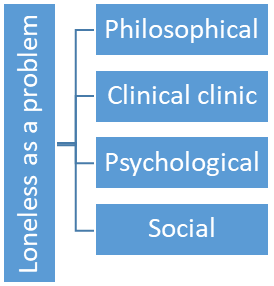
Figure
Problem Statement
Residents of the modern megapolis have not only a large quantitative, but also qualitative expression of the state of loneliness in comparison with migrants from the countries of Central Asia.
Research Questions
-
To distinguish the quantitative difference of the total indicators between the residents and migrants of the megapolis of Yekaterinburg in the presented sample.
-
Identify the qualitative differences in the psychological state of loneliness in both study groups.
Purpose of the Study
Compare the inhabitants of the Russian mega polis with migrants from Central Asia for the presence of loneliness in their psychological or world outlook structure of self-awareness.
Research Methods
For the presented study, 2 samples were selected, each with a population of 50, regardless of gender, age, or educational factor. The first sample was made by the indigenous inhabitants of such a megapolis as the city of Yekaterinburg, whose population as of June 1, 2016 is 1,455,904 people. It included people living in all areas of the megapolis. The second sample included migrants from the countries of Central Asia, whose number is about 65% of the total flow entering Yekaterinburg. Each of the subjects was asked to undergo a psychometric technique called "Differential Questionnaire of Loneliness Experiences", which is a complete questionnaire of 40 questions, correlated with 8 subscales and 3 scales. This technique is an original diagnostic tool, characterized by a qualitative support for fundamental theoretical knowledge of the problem of loneliness, as well as scientific novelty and accuracy of the construction of the existential profile. The methodology was developed in 2013 by Osin & Leontiev. The questionnaire reveals the data in the contents of the following subscale:
subscale 1 "isolation" - indicates the absence of close people with whom close emotional contact is possible;
subscale 2 "experience of loneliness" - contains statements constructing the image of the self as a lonely person;
subscale 3 "alienation" - emphasizes the lack of meaningful links with people;
subscale 4 "dysphoria of loneliness" - reveals the negative experiences associated with a person's being in a state of loneliness;
subscale 5 "loneliness as a problem" - reflects a person's overall negative assessment of loneliness as a phenomenon;
subscale 6 "the need for the company" - measures the need for communication;
subscale 7 "the joy of solitude" - measures a person's ability to appreciate loneliness and solitude;
subscale 8 "resource of solitude" - contains statements reflecting the dignity and possibilities of the situation of loneliness.
The sum of subscales 1-3 determines the score of the big scale "total loneliness", reflecting the actuality of loneliness in general. The sum of subscales 4-6 determines the score of the scale "dependence on communication", reflecting the rejection of loneliness. The sum of subscales 7-8 determines the score of the scale "positive loneliness", which determines the resource of solitude, the possibility of creative solutions in this state for the benefit of using the latter for specific purposes of self-realization and self-actualization (Loyko et al., 2016). The list of statements of the full version of the psychodiagnostic methodology "differential questionnaire of the experience of loneliness" is as follows:
I feelthat I aminharmonywith the peoplearoundme;
I feellonely;
formeitisnotsoimportantwhetherotherpeoplesurroundme;
I lackfriendlycommunication;
whenthereisnobodybesideme, I ambored;
I liketobealonewithmyself;
there are nopeoplewithwhom I wouldbereallyclose;
I feelmyselfpartof a groupoffriends;
I donotliketostayalone;
thereisnoonetowhom I couldturn;
Singlepeopleneedhelp;
I finditdifficulttofindpeoplewithwhom I couldsharemythoughts;
I havelittleincommonwiththosewhosurroundme;
I liketodreamalone;
I alwayslackcommunication;
lonelyinterestingideascome;
if a personislonely, thenhehasproblemscommunicating;
It'shardformetobeawayfrompeople;
There are feelingsthatyoucanonlyfeelwithyourself;
There are peoplewhoreallyunderstandme;
There are peoplewithwhom I cantalk;
Tounderstandsomeimportantthings, oneneedstoremainalone;
When I amalone, I donotexperienceunpleasantfeelings;
I feelabandoned;
The headworksbetteralone;
The familyneeds a person, becauseithelpstosaveoneselffrom loneliness;
The peoplearoundme, butnotwithme;
In solitude, a manknowshimself;
Mysocialconnections are notdeep;
I donottolerate the absenceof the company;
I feelaloneinmysolitude;
The worstthingthatcanbedonewith a personistoleavehimalone;
The deprivationofcommunicationisnoteasiertoendurethan the deprivationofwaterandfood;
itseemstomethatnooneunderstandsme;
when I amalone, onlydrearythoughtscometomymind;
I feelgoodathomewhen I amalone;
When I amalone, I experiencediscomfort;
evenalonewithyourselfyoucannotfeellonely;
Withoutcommunicationwithpeople, a personloseshimself;
inisolation, everyoneseesinhimselfwhathereallyis.
Findings
For the presentation of the counting system, it will be advisable to present Table
Having diagnosed a sample of 50 migrants and further diagnosed the sample as well from 50 people, we obtained the following quantitative indicators. The quantitative ratio of respondents in percentage equivalent that scored high scores on the "insulation" subscale is shown in Figure
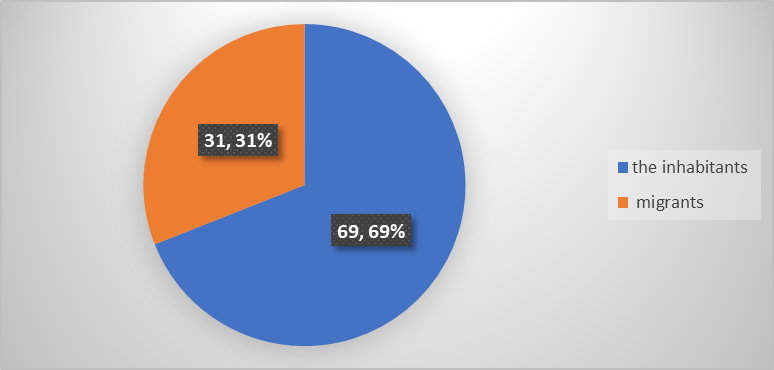
As we see in Figure

Figure

The results for the subscale "dysphoria" as shown in Figure
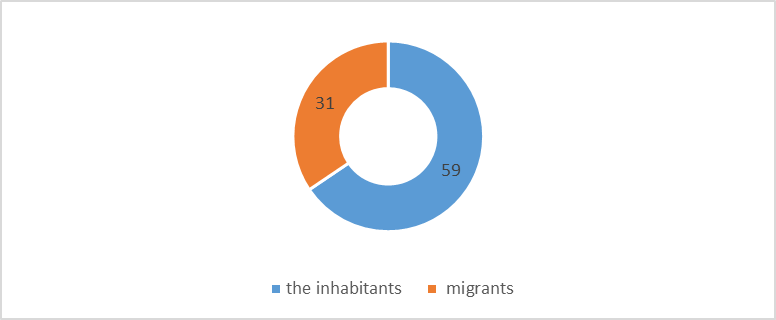
From the diagram of the relationshipsinFigure
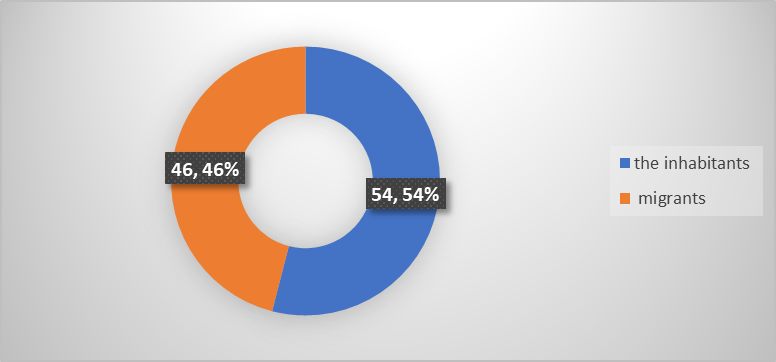
From the ring diagram 06, we see that in the category of results for the subscale "need for a company", migrants from the countries of Central Asia received large percentage positions with a preponderance of 8%. The joy of seclusion and the resource of solitude for the benefit of self-realization are more characteristic of migrants from Central Asia than residents of such a megapolis as Yekaterinburg. The above data are a reflection of quantitative differences in the structure of comparison of two samples by means of a psychodiagnostic methods. It is worth noting that the quality of the state of loneliness in this technique is determined with greater probability by 3 scales, which are constructed from the selective characteristics of the subscale and reflect the duality of the problem of loneliness, that is, its negative and positive aspect. Qualitative differences are shown in Figure
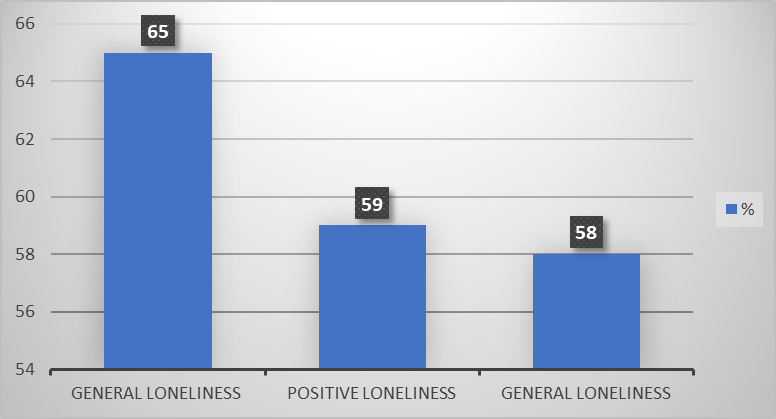
As we can see from Fig.
Conclusion
Psychodiagnostic research using the method "differential questionnaire of the experience of loneliness" gave results to determine that residents of such a megapolis as Yekaterinburg are more likely to experience the state of loneliness than migrants from the countries of Central Asia. The experience of loneliness is expressed in the difference not only in the quantitative characteristics, but also in the quality of the given psychological state, which confirms our hypothesis. The measurement showed that the inhabitants of the megapolis experience a more painful state of loneliness, with a lack of close emotional relations, with unstable social ties. At the same time, emotional dependence on communication was noted, but the inability to improve this structure. The state of loneliness by the inhabitants of the megapolis Yekaterinburg, despite the opportunities for the level of urbanization of this territorial structure, is used as a positive resource, in percentage ratio less than migrants from Central Asia (41% and 59% respectively) (Malushko et al., 2016).
The problem of loneliness of residents and migrants in the megapolis is actual in our time and requires further in-depth, focused study. Based on the results of the presented research, it is possible to outline the directions for the subsequent search of tools for increasing the identity of migrants in the megapolis and conflict resources in the context of the psychological phenomenon under consideration, as well as reflecting the intersubject connections of urban development and the satisfaction of the resident and migrant of the given territorial structure (Politsinskaya et al., 2016).
References
- Andangsari, E. W, Dhowi, B. (2016). Two Typology Types of Loneliness and Problematic Internet Use (PIU): An Evidence of Indonesian Measurement Link to Your Paper. Advanced Science Letters, 22 (5), 1711-1714.
- Dementeva, S.V., Franzke,C.M. &Loyko O.T. (2015). Russian-German Immigrants in Germany and their Intercultural Communication, Procedia - Social and Behavioral Sciences, 166, 516-520.
- Lur'e, S. (2005). Psychological anthropology. Moscow: Alma Mater, Akademicheskiiprekt.
- Lizunkov, V. G., Minin, M. G., Malushko, E. Y., & Medvedev, V. E. (2016). Developing economic and managerial competencies of bachelors in mechanical engineering. SHS Web of Conferences, 28, Article number 01063, 1-5.
- Lizunkov, V.G., Marchuk, V.I., & Podzorova, E.A. (2015). Identification of Criteria, Features of Development and Level of Economic and Managerial Competencies of Bachelors in Mechanical Engineering. Procedia - Social and Behavioral Sciences, 206, 388-393.
- Loshchilova, M.A., Lizunkov, V.G., & Zavjyalova, A.V. (2015). Professional Training of Mechanical Engineering Bachelors, Based on Network Resources. Procedia - Social and Behavioral Sciences, 206, 399-405.
- Malushko, E., Maletina, O., Lizunkov, V., & Tsybaneva V. (2016). Use of virtual learning system for educating students with disabilities and special needs. 3rd International Multidisciplinary Scientific Conference on Social Sciences and Arts, SGEM 2016: conference proceedings. BK 1: Psychology And Psychiatry, Sociology And Healthcare, Education Conference Proceedings, Vol I. Bulgary, Albena.
- Loyko, O.T., Dryga, S.V., Park, Jae, & Palianov, M.P. (2015). Modern Professional Education in the Global Society: Comparative Study. Procedia - Social and Behavioral Sciences, 464 – 468.
- Politsinskaya, E. V., Sushko, A. V., Semerenko, I. A. (2016). Formation of the Professional Competence of a student within the framework of the problem-oriented approach to training. SHS Web of Conferences, 28, Article number 01083, 1-5.
- Osin, E.N., Leontiev, D.A. (2013). Differential questionnaire for experiencing loneliness: structure and properties. Psychology. Journal of the Higher School of Economics, 10 (1), 55-81
- Routasalo, P., Pitkala, K. (2003). Loneliness among older people. Reviews in Clinical Gerontology, 13(4), 303-311
- Shagivaleeva, G. (2014). Loneliness as a social and psychological phenomenon. World Applied Sciences Journal, 30(2), 226-231.
- Weis, R. (1989). Questions of studying loneliness. Labyrinths of loneliness. Moscow: Progress.
Copyright information

This work is licensed under a Creative Commons Attribution-NonCommercial-NoDerivatives 4.0 International License.
About this article
Publication Date
16 April 2018
Article Doi
eBook ISBN
978-1-80296-037-2
Publisher
Future Academy
Volume
38
Print ISBN (optional)
-
Edition Number
1st Edition
Pages
1-509
Subjects
Social welfare, social services, personal health, public health
Cite this article as:
Blaginin, V., Ergunova, O., & Pyankova, S. (2018). Loneliness As A Social Problem Of A Modern Metropolis. In F. Casati, G. А. Barysheva, & W. Krieger (Eds.), Lifelong Wellbeing in the World - WELLSO 2017, vol 38. European Proceedings of Social and Behavioural Sciences (pp. 71-79). Future Academy. https://doi.org/10.15405/epsbs.2018.04.9

